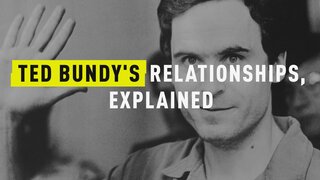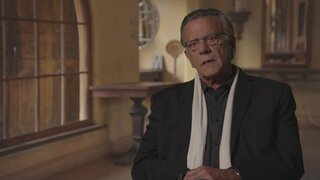Create a free profile to get unlimited access to exclusive videos, breaking news, sweepstakes, and more!
Where Did Ted Bundy Finally Get Caught? Well, It's Complicated
While authorities in Utah believed Ted Bundy was linked to numerous killings across the Northwest and initially convicted him of kidnapping, it would be several years and several escapes from custody before Bundy was put behind bars for good.
Notorious serial killer Ted Bundy had been relying on his charm and good looks to lure innocent women across the Northwest before brutally raping, beating, and killing them.
But after each mysterious disappearance, Bundy would once again vanish into a cloak of anonymity leaving investigators baffled and communities terrorized.
That is, until one August night in 1975, when a wrong turn at 3 A.M. would finally land Bundy in the crosshairs of police.
Bob Hayward had been a sergeant with the Utah Highway Patrol that night and was sitting in his cruiser finishing his shift log outside his home when he noticed a Volkswagen drive by his car, according to an Associated Press article published in 2000.
A few moments later, a call came over the radio requesting assistance. Hayward decided to respond, but after taking a wrong turn out of the subdivision, he’d stumble onto one of the most prolific serial killers the country has ever seen instead.
Hayward immediately noticed the same Volkswagen that he’d seen just minutes earlier, but this time it was parked in front of one of his neighbor’s homes. He thought this was odd considering the parents of the family were out of town, leaving their 17-year-old and 19-year-old daughters at the home, alone.
After the driver saw Hayward’s vehicle, the Volkswagen quickly fled but Hayward chased after the car in his cruiser. When the Volkswagen finally pulled over, Hayward told the AP he saw the driver was a man clad in a black turtleneck with shaggy hair. It would be the trooper’s greatest stop of his career.
The man told Hayward he was a law student from the University of Utah and was simply lost, according to a 2015 article from Utah station KTVX.
But it was the man’s description of where he’d been earlier that night that roused further suspicion. He claimed he had spent the night at the drive-in movie theater.
“I said what’s playing, cause I’d been working out there all night,” Hayward later recalled. “I’d know what was playing and he says 'The Towering Inferno' which was wrong.”
Hayward asked if he could search the vehicle and noticed the passenger seat was completely missing.
“I found pantyhose, holes cut in it, different stuff for burglary tools, a little crowbar and things that most people wouldn’t carry in a car like that,” he said.
Hayward, who died in 2017 at the age of 90 after serving as a state trooper for 33 years, arrested Bundy and charged him with suspicion of evading after his story just didn’t check out, according to The Salt Lake Tribune.
"There's no doubt in my mind in the condition and what he had there, the crowbar, the whole thing that that was his prey for the night," he told KTVX. "He was going in that house."
Hayward was suspicious that Bundy may have been guilty of more than just evading police and mentioned the arrest to his brother, Pete Hayward, who was in charge of detectives for the Salt Lake County Sherriff’s Office.
Detectives there, including Ben Forbes and Jerry Thompson, immediately recalled a tan Volkswagen and the name Bundy. They had been notified of the name by Seattle investigators a year earlier after one of Bundy’s former girlfriends had reported his suspicious behavior to authorities in Washington and demanded they contact law enforcement officers in Salt Lake as well, the AP reports.
When investigators in both states conferred after Bundy’s arrest, Utah detectives discovered that 10 women had disappeared in Washington and Bundy had been on a list of possible suspects in the disappearances.
“It was like a whole euphoric situation when that call came in,” Robert Keppel, an investigator in Washington, later recalled to the AP.
Several women at the time had also disappeared in Utah, and the vehicle and Bundy’s physical characteristics also matched the description given by Carol DaRonch, an 18-year-old who managed to escape a kidnapping on Nov. 8, 1974, after being handcuffed inside a tan Volkswagen.
Bundy had told the young woman he was a police officer and needed her to come down to the station because her car had been broken into, but shortly into their drive he stopped the car and put handcuffs on her before she managed to flee, PEOPLE reports.
But while Hayward’s stop in August would ultimately lead to Bundy’s arrest and later conviction for kidnapping DaRonch, it wouldn’t be the last time Bundy would face-off with authorities.
Shortly after being convicted of kidnapping in Utah in 1976, Bundy was extradited to Colorado to stand trial on murder charges there. But he’d slip out of custody twice while in the state, eventually heading to Florida in January 1978 after a daring prison escape.
Just weeks later, he’d sneak into a sorority house in Tallahassee, Florida and bludgeoned four women, killing two of them, the AP reports.
Then, on February 9, 1978, 12-year-old Kimberly Leach would vanish from her junior high school in Lake City, Florida.
Her friend Lisa Little said Leach had been getting her purse from her homeroom when she disappeared, according to WCJB.
"I stood at the stairs waiting for her and she didn't show up,” Little told the station in 2018.
A few days later, Bundy would be caught a final time by a Pensacola Police officer.
Bundy had allegedly been driving out of town on February 15, 1978 when he was suddenly struck by an uncontrollable urge, former Pensacola Police Chief Norman Chapman told Florida station WEAR last year.
“He left Pensacola on his way to Mobile, and he got the urge to take another person,” Chapman said. “So, he came in the last exit, came back into Pensacola and he stopped behind Oscar Woerner’s.”
Bundy parked behind the historic restaurant and began peeping into homes. By 1 A.M., the orange Volkswagen was still parked in the empty lot of the restaurant. When he got back in and began to drive away, Lee noticed the car and was suspicious so he ran the tag. He discovered the vehicle was stolen.
Initially, officers didn’t realize who they’d caught. Bundy gave a fake name and didn’t give police his real name for almost two days. The mugshot from the Pensacola Police Department obtained by Oxygen.com shows a dark-haired Bundy with a thin mustache, wearing a black turtleneck, as he averts his eyes from the camera.
Chapman, who was an investigator with the department at the time, was assigned the case.
“He was very personable, very charismatic, very unalarming, and see, that’s the dangerous thing,” he said later of his first meeting with Bundy.
Investigators discovered Bundy had provided a false name when the student whose identity he had assumed later called the station, saying, “I don’t know who it is you got in jail, but it’s not me,” lead prosecutor George R. Dekle Sr. said, according to the Pensacola News Journal.
Even after Bundy revealed his identity, Chapman said he didn’t know who Ted Bundy was. He’d soon learn the charismatic man was suspected of killing dozens of women across the country.
Chapman spent 40 hours talking to Bundy, learning some details no other investigator was able to discover.
“As he told me, ‘You know I couldn’t go to anyone with my problem and tell them what my problem was,’ because his problem was killing people,” Chapman said.
After recovering a stolen Florida State University van that Bundy had taken before the orange Volkswagen, Dekle said they discovered a “treasure trove” of evidence linking him to Leach’s disappearance including blood stains and clothing fibers.
"There was a perfect storm of evidence tying up Ted Bundy as the perpetrator of this crime," Dekle said.
After a trial that quickly became a media spectacle, Bundy was convicted for the three killings in Florida in 1979.
A decade later, in 1989, he died in the electric chair, but the mass murderer may never have been stopped if it wasn’t for those two traffic stops, thousands of miles apart, that finally brought an end to Bundy’s reign of terror.
[Photo: Netlfix/Pensacola Police Department]






























